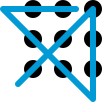Outside the Box by Arcadia
Puzzle explanation
The puzzle illustrated a variety of solutions to the puzzle of connecting a grid of points with a small number of straight lines drawn continuously, ie without lifting the pen from the drawing surface. These variations and others were described in the book Conceptual Blockbusting: A Guide to Better Ideas by Stanford University professor James L Adams (who died in January 2022), published from 1974 to 2019. In a talk about “conceptual blocks”, Adams presented the original puzzle of drawing four connected lines through a 3×3 grid of dots, as a demonstration of how limiting our thinking to staying “inside the box” can overlook solutions such as the “correct” one shown here. This corresponded to tracing PATROLMAN in the southwest corner of the grid.

However, people then came up with many other solutions, showing Adams that his own thinking had been limited by “knowing” the correct one. The first alternative was to use three angled lines, because the rules didn’t say that the lines had to go through the centres of the dots. In the grid, this was represented by the lines through DIFFER, ENTÊTÉ, ROSSER, PERUSE and DOBBER in the middle rows.

Another solution was (theoretically) to draw one line angled very slightly to a great circle of the globe (in effect, a “straight” line on the Earth’s surface) such that when it returns to the paper with the dots it passes through the second and third rows. The same effect is more easily achieved by rolling the paper into a cylinder and drawing one line around it. This was represented by the grid’s near-vertical line that conceptually continued below the bottom and reappeared at the top of the next column, passing through the answers ELDEST HAND, PRAIRIE OYSTERS and PARASELENE.

A ten-year-old girl from Puerto Rico wrote a letter to Adams with the simple solution of drawing one thick line through all the dots — because the problem “doesn’t say you can’t use a fat line”. The corresponding grid treatment was the shading of the last two columns. Other suggested solutions involved cutting and rearranging the paper, or ingeniously folding it, so that the nine dots are all in a row.

Clue explanations
Conventions: * = anagram, < = reversal
| Answer | Explanation |
|---|---|
| Traced by lines | |
| PATROLMAN | PAT + ROMAN around L |
| DIFFER | DIPPER with FF for PP |
| ENTÊTÉ | (bu)T in (EN ÉTÉ) |
| ROSSER | (c)ROSSER |
| PERUSE | PERUKE with S for K |
| DOBBER | ROBBED with outer letters swapped |
| ELDEST HAND | (HE’S DEALT) * + AND − A |
| PRAIRIE OYSTERS | (PRIORY’S TEAS) * around (R + IE) |
| PARASELENE | (LASER * + E) in PANE |
| Original answers | |
| AIDE-DE-CAMP | DECAMP after IDEA * |
| ALAN | (farcic)AL AN(tics) |
| ANTHER | (l)ANTER(n) around H |
| BAHT | 2 meanings; ref. the song On Ilkla Moor Baht ’at |
| BISTRO | BIRO around (A)ST(i) |
| CAREERISTS | SIRE < in CARETS |
| CHANEL | CHANNEL − N |
| COSE | SO < in CE |
| ELSE | ELSIE − I; ref. sisters in a treacle well in Alice’s Adventures in Wonderland |
| EOAN | EA around O + N |
| ERICA | (A(ttempted) C(oup) I(n) R(eplacing) E(dward)) < |
| FLAUNCHES | F + LAUNCHES |
| HALE | homophone of HAIL |
| ICESTONE | ICES + TONE |
| INGA | ((st)AG NI(ght)) < |
| INULAS | INSULA with S moved down |
| IRATELY | ELY after (p)IRAT(e) |
| ISOGONAL | ISL around (NO-GO < + A) |
| KUNG FU | KÜNG + F + U |
| LEKYTHOS | (SOH + TYKE + L) < |
| MARAS | AS after MAR |
| NAAN | NATHAN − TH(e) |
| OTIC | O + TIC |
| PLOY | PLOTTY − TT |
| SLATER | SLAT + RE < |
| TEASELED | EASE in DELT < |
| TITLES | TIT(i) + LES |
| TRALEE | RÂLE in (T + E) |
| VOUVRAY | homophone of (VOUS + VRAI) |
